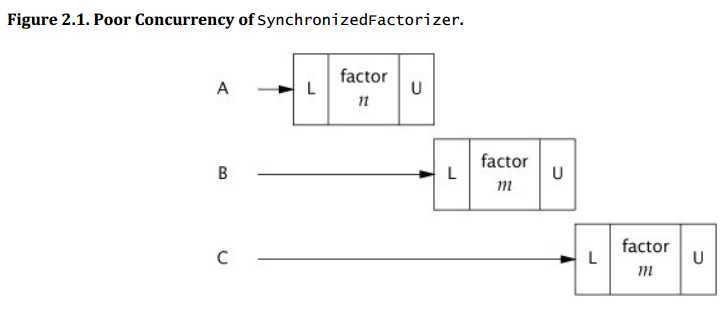标签:des style blog class code c
Writing thread-safe code is managing access to state and in particular to shared, mutable state.
Object‘s state is its data, stored in state variables such as instance or static fields.
Whether an object needs to be thread-safe depends on whether it will be accessed from multiple threads.
Synchronization includes
Ways to avoid inappropriate synchronization with multiple threads access.
Good practice on designing thread-safe classes
2.1 What is Thread Safety
A class is thread-safe if it behaves correctly when accessed from multiple threads, regardless of the scheduling or interleaving of the execution of those threads by the runtime environment, and with no additional synchronization or other coordination on the part of the calling code.
Thread safe classes encapsulate any needed synchronization so that clients need not provide their own.
Stateless objects are always thread-safe.
eg. It is only when servlets want to remember things from one request to another that the thread safety requirement becomes an issue.
2.2 Atomicity
Classic operation scenario
2.2.1 Race Conditions
A race condition occurs when the correctness of a computation depends on the relative timing or interleaving of multiple threads by the runtime.
@NotThreadSafe public class LazyInitRace { private ExpensiveObject instance = null; public ExpensiveObject getInstance() { if (instance == null) instance = new ExpensiveObject(); return instance; } }
Operations A and B are atomic with respect to each other, from the perspective of a thread executing A, when another thread executes B, either all of B has executed or none of it has. An atomic operation is one that is atomic with respect to all operations, including itself, that operate on the same state.
@NotThreadSafe public class UnsafeCountingFactorizer implements Servlet { private long count = 0; public long getCount() { return count; } public void service(ServletRequest req, ServletResponse resp) { BigInteger i = extractFromRequest(req); BigInteger[] factors = factor(i); ++count; encodeIntoResponse(resp, factors); } }
The java.util.concurrent.atomic package contains atomic variable classes for effecting atomic state transitions on
numbers and object references. By replacing the long counter with an AtomicLong, we ensure that all actions that
access the counter state are atomic.
@ThreadSafe public class CountingFactorizer implements Servlet { private final AtomicLong count = new AtomicLong(0); public long getCount() { return count.get(); } public void service(ServletRequest req, ServletResponse resp) { BigInteger i = extractFromRequest(req); BigInteger[] factors = factor(i); count.incrementAndGet(); encodeIntoResponse(resp, factors); } }
Principle
Where practical, use existing thread-safe objects, like AtomicLong, to manage your class‘s state. It is simpler to reason about the possible states and state transitions for existing thread-safe objects than it is for arbitrary state variables, and this makes it easier to maintain and verify thread safety.
2.3 Locking
Dealing with more than one states currency operations within one object.
Principle
To preserve state consistency, update related state variables in a single atomic operation.
2.3.1 Intrinsic Locks
A synchronized block has two parts: a reference to an object that will serve as the lock, and a block of code to be guarded by that lock. A synchronized method is shorthand for a synchronized block that spans an entire method body, and whose lock is the object on which the method is being invoked. (Static synchronized methods use the Class object for the lock.)
2.3.2 Reentrancy
Reentrancy means that locks are acquired on a per-thread rather than per-invocation basis.
When a thread acquires a previously unheld lock, the JVM records the owner and sets the acquisition count to one. If that same thread acquires the lock again, the count is incremented, and when the owning thread exits the synchronized block, the count is decremented. When the count reaches zero, the lock is released.
2.4 Guarding State with Locks
For each mutable state variable that may be accessed by more than one thread, all accesses to that variable must be performed with the same lock held.
For every invariant that involves more than one variable, all the variables involved in that invariant must be guarded by the same lock.
put-if-absent operation
if (!vector.contains(element)) vector.add(element);
2.5 Liveness and Performance

Refined solution for concurrent operation on more than on state object inside the Class instance
@ThreadSafe public class CachedFactorizer implements Servlet { @GuardedBy("this") private BigInteger lastNumber; @GuardedBy("this") private BigInteger[] lastFactors; @GuardedBy("this") private long hits; @GuardedBy("this") private long cacheHits; public synchronized long getHits() { return hits; } public synchronized double getCacheHitRatio() { return (double) cacheHits / (double) hits; } public void service(ServletRequest req, ServletResponse resp) { BigInteger i = extractFromRequest(req); BigInteger[] factors = null; synchronized (this) { ++hits; if (i.equals(lastNumber)) { ++cacheHits; factors = lastFactors.clone(); } } if (factors == null) { factors = factor(i); synchronized (this) { lastNumber = i; lastFactors = factors.clone(); } } encodeIntoResponse(resp, factors); } }
Principle
Java Concurrency In Practice -Chapter 2 Thread Safety,布布扣,bubuko.com
Java Concurrency In Practice -Chapter 2 Thread Safety
标签:des style blog class code c
原文地址:http://www.cnblogs.com/haokaibo/p/Thread-Safety.html